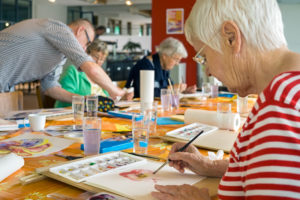
Paint brushes and IV tubes may not seem to have much in common, but the arts are increasingly touted as a form of healing that can be as relevant to a patient’s well-being as medication. And nearly half the healthcare institutions in the U.S. have implemented arts programs.
Apart from empowering patients, practicing an art form while sick may improve certain symptoms – like lowering blood pressure. It also fulfills a patients’ instinctive need to express their feelings about what is going on in their bodies.
Studies have shown that painting and drawing can relieve pain in pediatric cancer patients and that dementia patients who practice music may improve their memory. Preliminary research on the potential economic benefits of hospitals’ arts programs shows that participating patients have a lower readmission rate and are more compliant with taking their medications.
Arts programs may also improve the hospital’s working environment: Studies have shown that nurses report less stress when patients are involved in art projects. According to a 2009 report by the Global Alliance for Arts and Health, 45 percent of the country’s health care institutions (mostly hospitals) have art programs – predominantly through art displays and performances, bedside activities, art carts, and healing gardens.
The country’s first programs began in the 1970s and 1980s – at academic medical centers such as Duke and the University of Michigan. Jill Sonke, one of the authors of the Global Alliance report, says their rise coincided with the recognition of holistic medicine.
“The arts went along with that so perfectly,” says Sonke, who directs the Arts in Medicine Program at the University of Florida, one of the country’s first programs.
Also a professional dancer, Sonke runs a UF program called Dance for Life, in which patients with neurodegenerative disorders such as Parkinson’s disease improve their mobility and balance.
Sonke is careful to distinguish between art therapists and artists working in hospitals. “Art therapists are mental health professionals who use the arts to assess and address patients’ therapeutic goals,” she says. “Professional artists are not clinicians; they partner with caregivers to help meet clinical goals.”
For patients, working with artists is often relaxing and enjoyable, she says. “It gives patients a deep sense of caring that someone would spend time attending to them as a human being.”
As we can see, art therapy often has a mystical effect on people with varying conditions that uplifts their hearts and minds which can ultimately result in their overall well-being. The next time your loved one is having a bad day, think about lifting their spirits with the ARTS.



March 7, 2018
Healing Power of Art
Apart from empowering patients, practicing an art form while sick may improve certain symptoms – like lowering blood pressure. It also fulfills a patients’ instinctive need to express their feelings about what is going on in their bodies.
Studies have shown that painting and drawing can relieve pain in pediatric cancer patients and that dementia patients who practice music may improve their memory. Preliminary research on the potential economic benefits of hospitals’ arts programs shows that participating patients have a lower readmission rate and are more compliant with taking their medications.
Arts programs may also improve the hospital’s working environment: Studies have shown that nurses report less stress when patients are involved in art projects. According to a 2009 report by the Global Alliance for Arts and Health, 45 percent of the country’s health care institutions (mostly hospitals) have art programs – predominantly through art displays and performances, bedside activities, art carts, and healing gardens.
The country’s first programs began in the 1970s and 1980s – at academic medical centers such as Duke and the University of Michigan. Jill Sonke, one of the authors of the Global Alliance report, says their rise coincided with the recognition of holistic medicine.
“The arts went along with that so perfectly,” says Sonke, who directs the Arts in Medicine Program at the University of Florida, one of the country’s first programs.
Also a professional dancer, Sonke runs a UF program called Dance for Life, in which patients with neurodegenerative disorders such as Parkinson’s disease improve their mobility and balance.
Sonke is careful to distinguish between art therapists and artists working in hospitals. “Art therapists are mental health professionals who use the arts to assess and address patients’ therapeutic goals,” she says. “Professional artists are not clinicians; they partner with caregivers to help meet clinical goals.”
For patients, working with artists is often relaxing and enjoyable, she says. “It gives patients a deep sense of caring that someone would spend time attending to them as a human being.”
As we can see, art therapy often has a mystical effect on people with varying conditions that uplifts their hearts and minds which can ultimately result in their overall well-being. The next time your loved one is having a bad day, think about lifting their spirits with the ARTS.